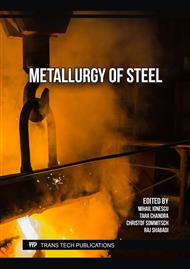[1]
T. Taylor, A. Clough, Critical review of automotive hot-stamped sheet steel from an industrial perspective, Mater. Sci. Technol. (United Kingdom). 34 (2018) 809–861.
DOI: 10.1080/02670836.2018.1425239
Google Scholar
[2]
D.K. Matlock, S. Kang, E. De Moor, J.G. Speer, Applications of rapid thermal processing to advanced high strength sheet steel developments, Mater. Charact. 166 (2020) 110397.
DOI: 10.1016/j.matchar.2020.110397
Google Scholar
[3]
H. Pantsar, Relationship between processing parameters, alloy atom diffusion distance and surface hardness in laser hardening of tool steel, J. Mater. Process. Technol. 189 (2007) 435–440.
DOI: 10.1016/j.jmatprotec.2006.08.033
Google Scholar
[4]
S. Singh, D. Gupta, V. Jain, A.K. Sharma, Microwave processing of materials and applications in manufacturing industries: A Review, Mater. Manuf. Process. 30 (2015) 1–29.
Google Scholar
[5]
N. Demazel, H. Laurent, M. Carin, P. Le Masson, H. Salmon-Legagneur, A direct resistance heating method for shaped blank, J. Manuf. Process. 62 (2021) 772–783.
DOI: 10.1016/j.jmapro.2020.12.056
Google Scholar
[6]
Z. Shao, J. Jiang, J. Lin, Feasibility study on direct flame impingement heating applied for the solution heat treatment, forming and cold die quenching technique, J. Manuf. Process. 36 (2018) 398–404.
DOI: 10.1016/j.jmapro.2018.10.020
Google Scholar
[7]
Y. Koizumi, T. Otsuka, Y. Minamino, T. Takayama, M. Ueyama, T. Daio, S. Hata, Microstructures developed by super-rapid induction heating-and-quenching (SRIHQ) of Fe–1.4%Cr–1%C pearlitic steel, Mater. Sci. Eng. A. 577 (2013) 29–35.
DOI: 10.1016/j.msea.2013.04.024
Google Scholar
[8]
Y. Liu, K. Iwata, S. Sanda, M. Nishiyama, Utilization of motion capture systems for low cycle fatigue tests on induction-hardened steel, J. Constr. Steel Res. 190 (2022) 107166.
DOI: 10.1016/j.jcsr.2022.107166
Google Scholar
[9]
F.M. Castro Cerda, L.A.I. Kestens, A. Monsalve, R.H. Petrov, The Effect of Ultrafast Heating in Cold-Rolled Low Carbon Steel: Recrystallization and Texture Evolution, Met. 2016, Vol. 6, Page 288. 6 (2016) 288.
DOI: 10.3390/met6110288
Google Scholar
[10]
C. Lesch, P. Álvarez, W. Bleck, J. Gil Sevillano, Rapid transformation annealing: A novel method for grain refinement of cold-rolled low-carbon steels, Metall. Mater. Trans. A Phys. Metall. Mater. Sci. 38 A (2007) 1882–1890.
DOI: 10.1007/s11661-006-9052-y
Google Scholar
[11]
S. Sackl, H. Leitner, M. Zuber, H. Clemens, S. Primig, Induction Hardening vs Conventional Hardening of a Heat Treatable Steel, Metall. Mater. Trans. A Phys. Metall. Mater. Sci. 45 (2014) 5657–5666.
DOI: 10.1007/s11661-014-2518-4
Google Scholar
[12]
J.B. Lee, N. Kang, J.T. Park, S.T. Ahn, Y. Do Park, I.D. Choi, K.R. Kim, K.M. Cho, Kinetics of carbide formation for quenching and tempering steels during high-frequency induction heat treatment, Mater. Chem. Phys. 129 (2011) 365–370.
DOI: 10.1016/j.matchemphys.2011.04.026
Google Scholar
[13]
X. Wan, G. Liu, Z. Yang, H. Chen, Flash annealing yields a strong and ductile medium Mn steel with heterogeneous microstructure, Scr. Mater. 198 (2021) 113819.
DOI: 10.1016/j.scriptamat.2021.113819
Google Scholar
[14]
X. Wan, G. Liu, R. Ding, N. Nakada, Y.W. Chai, Z. Yang, C. Zhang, H. Chen, Stabilizing austenite via a core-shell structure in the medium Mn steels, Scr. Mater. 166 (2019) 68–72.
DOI: 10.1016/j.scriptamat.2019.03.015
Google Scholar
[15]
Q. Guo, B. Hu, H. Luo, Mechanism and Application of Reverse Austenitic Transformation in Medium Mn Steels: A Systematic Review, Steel Res. Int. 93 (2022) 2200257.
DOI: 10.1002/srin.202200257
Google Scholar
[16]
A. Hamada, A. Khosravifard, S. Ghosh, M. Jaskari, A. Järvenpää, P. Karjalainen, High-Speed Erichsen Testing of Grain-Refined 301LN Austenitic Stainless Steel Processed by Double-Reversion Annealing, Metall. Mater. Trans. A Phys. Metall. Mater. Sci. 53 (2022) 2174–2194.
DOI: 10.1007/s11661-022-06659-5
Google Scholar
[17]
A. Järvenpää, S. Ghosh, A. Khosravifard, M. Jaskari, A. Hamada, A new processing route to develop nano-grained structure of a TRIP-aided austenitic stainless-steel using double reversion fast-heating annealing, Mater. Sci. Eng. A. 808 (2021).
DOI: 10.1016/j.msea.2021.140917
Google Scholar
[18]
A. Khosravifard, A. Hamada, A. Järvenpää, P. Karjalainen, Enhancement of grain structure and mechanical properties of a high-Mn twinning-induced plasticity steel bearing Al–Si by fast-heating annealing, Mater. Sci. Eng. A. 795 (2020).
DOI: 10.1016/j.msea.2020.139949
Google Scholar
[19]
G. Liu, T. Li, Z. Yang, C. Zhang, J. Li, H. Chen, On the role of chemical heterogeneity in phase transformations and mechanical behavior of flash annealed quenching & partitioning steels, Acta Mater. 201 (2020) 266–277.
DOI: 10.1016/j.actamat.2020.10.007
Google Scholar
[20]
X. Liu, M. Zhou, X. Zhang, Ultra-flash annealing constructed heterogeneous austenitic stainless steel with excellent strength-ductility, Mater. Charact. 192 (2022) 112182.
DOI: 10.1016/j.matchar.2022.112182
Google Scholar
[21]
D.C. Saha, E. Biro, A.P. Gerlich, Y. Zhou, Effects of tempering mode on the structural changes of martensite, Mater. Sci. Eng. A. 673 (2016) 467–475.
DOI: 10.1016/j.msea.2016.07.092
Google Scholar
[22]
J. Ren, C. Li, Y. Han, E. Li, C. Gao, C. Qiu, Effect of initial martensite and tempered carbide on mechanical properties of 3Cr2MnNiMo mold steel, Mater. Sci. Eng. A. 812 (2021) 141080.
DOI: 10.1016/j.msea.2021.141080
Google Scholar
[23]
S.W. Young, M. Sato, K. Yamamitsu, Y. Shimada, Y. Zhang, G. Miyamoto, T. Furuhara, Effect of Alloying Elements on the High-Temperature Tempering of Fe-0.3N Martensite, Acta Mater. 206 (2021) 116612.
DOI: 10.1016/j.actamat.2020.116612
Google Scholar



